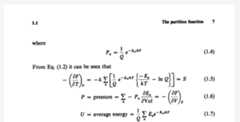This question may sound stupid. Consider a system at equilibrium. If we use the canonical ensemble, then the pressure of the system is(if I'm right)$$p=-\sum_s {p_s \frac{\mathbb d E_s}{\mathbb d V}},$$ where$p_s=\exp(-\beta E_s)/Z$ is the probability of the system in the microstate s. This formula actually works for ideal gas.
I am trying to figure out if this formula works for the microcanonical ensemble, or any other reasonable ensemble. If it works, then we just simply take every$p_s$ to be$1/\Omega$, where$\Omega$ is the total number of microstates of (the same) energy$E$. We could then obtain$p$ as a function of$E$ and$V$(and$N$). I tried it out for ideal gas and it gave the correct answer. Does this formula, when using the microcanonical ensemble or other ensembles, work for every system?
2 Answers2
Pressure is a statistical property. It cannot be defined for any particular microstate.
I don't think your canonical ensemble derivation is right, btw. Your notation does not indicate what are the independent variables, i.e. what is being held constant while$V$ is varied. For the ideal gas, there are no particle interactions so the energy of a microstate is not connected to the volume in any meaningful way. The pressure comes up only when you keep the entropy constant$p=-\left(\frac{\partial U}{\partial V}\right)_{S,N}$, which introduces dependence between$U$ an$V$.
As an example, why the independent variables are important, if you replace entropy with temperature in the derivative you get (for ideal gas)$\left(\frac{\partial U}{\partial V}\right)_{T,N} =0$. This, of course, no longer defines pressure; it just demonstrates the importance of specifying the set of independent variables in statistical-mechanics calculus.
- $\begingroup$In my derivation $E_s$ only depends on $V$, if I assume that $V$ is the onlymechanical parameter of the gas. Each microstate consists of N non-interacting plane waves in a square box of volume V=L^3, whose wavevectors satisfy periodic boundary. (Or, equivalently, you can choose other boundary conditions like 3D infinite square well. The result is same.)$\endgroup$astakus– astakus2025-10-30 08:13:25 +00:00Commented12 hours ago
- $\begingroup$The total energy for a microstate is $\hbar^2/{2m} \sum_{i=1}^N {\mathbf k_i^2}$, where k_i is the wave vector of the ith plane wave, and can be expressed as $\mathbf k_i=\frac{2\pi}{L}(n_{is}, m_{is}, l_{is})$, where n, m, and l are integers. So the eigenenergy is proportional to $L^{-2}$, i.e. $V^{-2/3}$. The 3N quantum numbers label the microstate s.$\endgroup$astakus– astakus2025-10-30 08:13:32 +00:00Commented12 hours ago
- $\begingroup$I assumed we're discussing classical mechanics. I'll edit my answer to account for quantum systems later$\endgroup$SmallPieceOfBread– SmallPieceOfBread2025-10-30 08:30:46 +00:00Commented12 hours ago
In statistical mechanics, the pressure$p$ is calculated from the Helmholtz free energy$F$:$$p = -\left( \frac{\partial F}{\partial V} \right)_{T,N},$$and the free energy$F$ is expressed in terms of the partition function$Z$:$$F = -T \ln Z, \qquad Z = \sum_s e^{-E_s/T}.$$Then,$$p = \frac{T}{Z} \left( \frac{\partial Z}{\partial V} \right)_{T,N} = - \sum_s p_s \left( \frac{\partial E_s}{\partial V} \right)_{T,N},$$where
$$p_s = \frac{e^{-E_s/T}}{Z}.$$The last two relations correspond to equations (1.4) and (1.6) in Feynman’sStatistical Mechanics. Since no assumption of an ideal gas is made in this derivation, these formulas hold for any system described by the canonical ensemble.
- 2$\begingroup$It's not clear what is meant by the derivative of a microstate energy with respect to the volume. Should you dilate all positions? If you change the volume it's not anymore the microstate $n$.$\endgroup$Syrocco– Syrocco2025-10-30 16:09:28 +00:00Commented4 hours ago
- $\begingroup$Did you use AI to write this answer?$\endgroup$Dale– Dale2025-10-30 20:00:04 +00:00Commented52 mins ago
Explore related questions
See similar questions with these tags.

